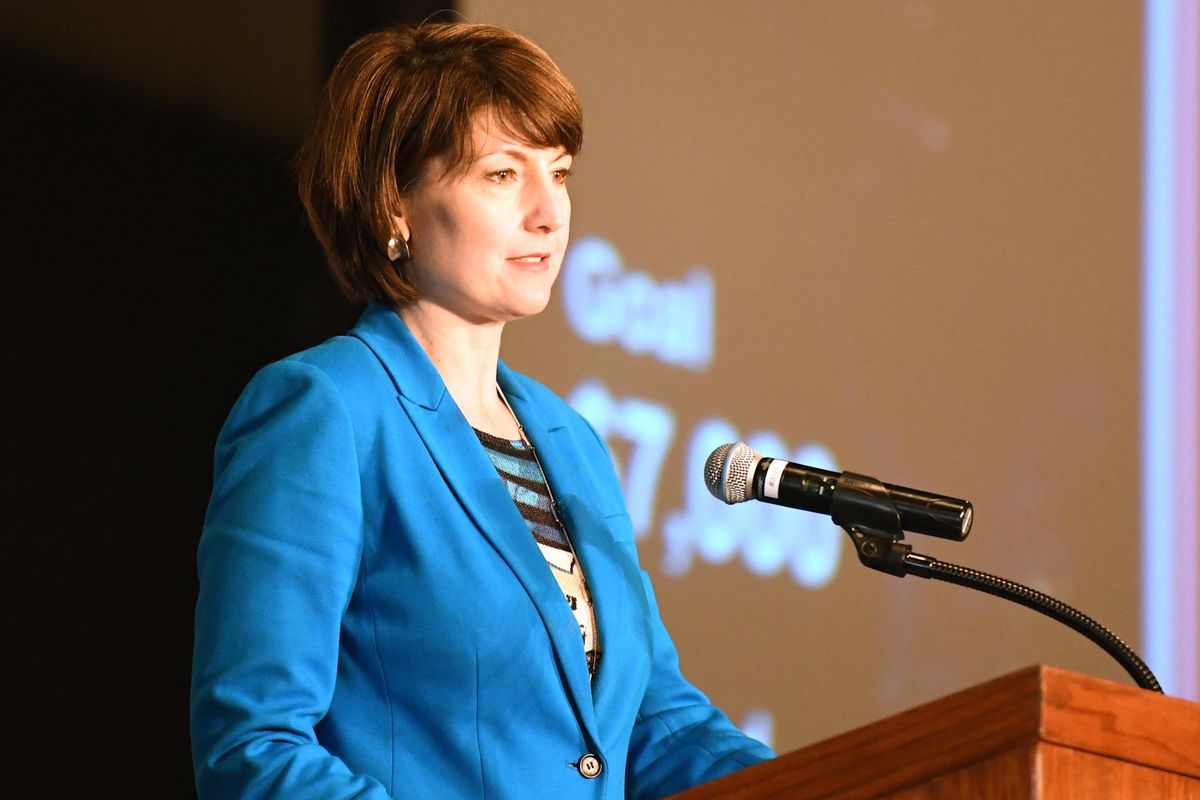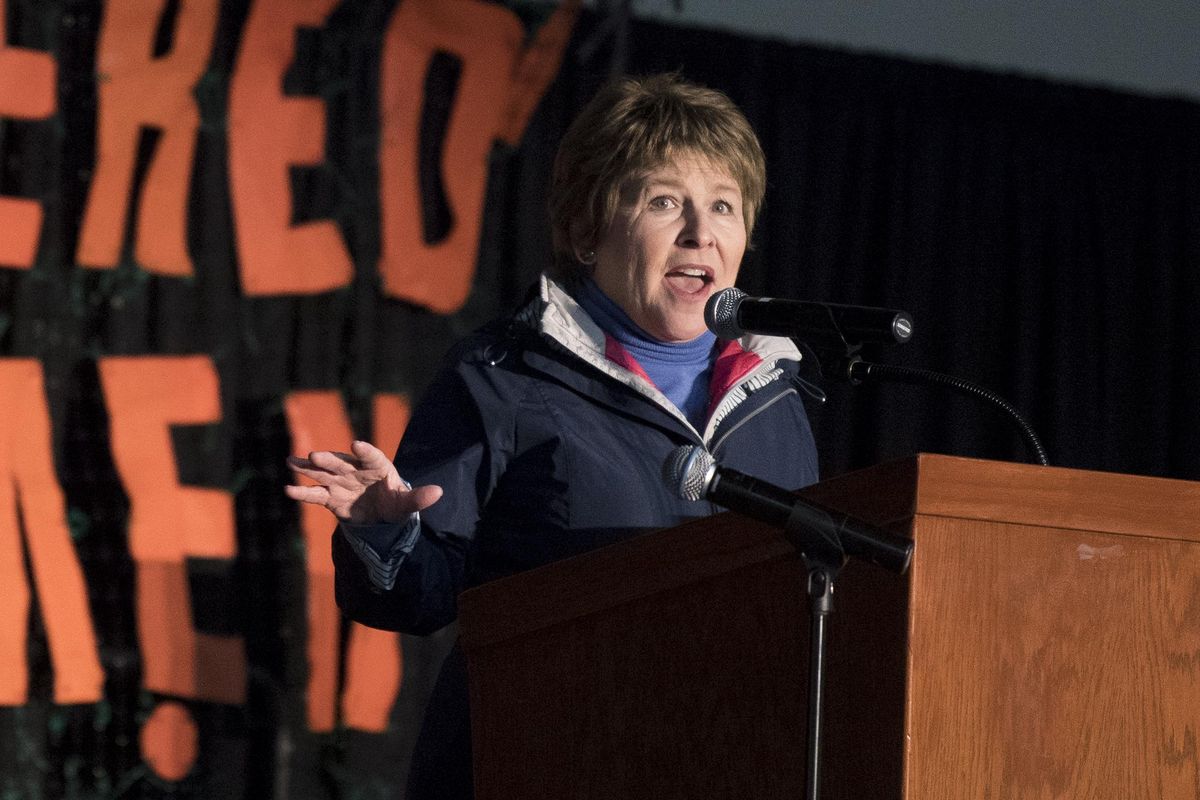Lisa Brown surges in fundraising, but Cathy McMorris Rodgers widens money margin in Congress race
FILE - Rep. Cathy McMorris Rodgers speaks at the MLK Day march, Monday, Jan. 16, 2017, at the Spokane Convention Center. (Jesse Tinsley / The Spokesman-Review)Buy a print of this photo
Democratic challenger Lisa Brown raised more money at the end of 2017 than the total earned by each of the previous four candidates seeking to unseat Rep. Cathy McMorris Rodgers.
Alhough Brown remains well behind her opponent in campaign money raised in her bid to topple the GOP’s fourth-ranking Republican in the House, her campaign is pointing to contribution totals, volunteer recruitment and growing national interest in the race as evidence that momentum is growing to turn Eastern Washington blue.
“We had a goal, and it was higher than our goal,” Brown, the former Washington state Senate majority leader and chancellor at Washington State University Spokane, said of the roughly $383,000 in contributions her team collected from September through December.
That amount is greater than the total cash raised by Joe Pakootas, Rich Cowan, Daryl Romeyn and Mark Mays, the last four Democrats to challenge McMorris Rodgers. But it falls well short of the $590,000 the high-ranking Republican added to her war chest over the same period.
Ashley Stubbs, a spokeswoman for the McMorris Rodgers campaign, said the congresswoman is seeing unprecedented backing in her pursuit of a seventh term in Congress.
“We’ve had equal record-breaking support,” Stubbs said. “We have over a million dollars of cash on hand.”
The congresswoman’s total cash on hand is more than double what Brown has available.
Contribution numbers come from year-end reports filed with the Federal Election Commission, the agency in charge of tracking political fundraising and spending in national political races. The most recent reports offer the first glimpse at the head-to-head money race emerging since Brown announced her candidacy in August.
Supporters of the Democrat emphasized that much of Brown’s money was raised by individuals living within the district, and pointed to the nearly $200,000 in donations McMorris Rodgers received from political action committees – organizations that raise money for campaigns that are subject to different reporting requirements and spending limits than individual donors – as evidence their support is more homegrown than the Republican’s.
“That, to me, is kind of the narrative, that kind of overwhelming amount of outside money is coming in,” Brown said. “So, no, we will not be able to compete with it.”
Stubbs did not provide the amount of money raised from donors in Eastern Washington, but she said half of the McMorris Rodgers campaign’s individual contributions since October have been less than $35. Stubbs also pointed out that just as a Paul Ryan-backed political committee has stated its intention to support the congresswoman, national-level Democrats have also jumped into the Eastern Washington fray.
“Nancy Pelosi, the (Democratic Congressional Campaign Committee) and other major players have shown their interest in the 5th District,” Stubbs said.
In an interview Thursday, McMorris Rodgers said she was confident her legislative record would resonate with voters.
“I’m running on my results of being an effective representative for the people of Eastern Washington,” the congresswoman said.
Brown said she has been collecting grassroots support from throughout the district.
“People are really looking at representation,” Brown said. “They’re skeptical about the special interests that seem to take over the incumbents.”
More than half of itemized donations to McMorris Rodgers came from Washington residents. Of the listed 402 individual itemized contributions to her campaign more than half – 235 – came from donors in Washington state. That number includes donations to McMorris Rodgers’ fundraising committee, McMorris Rodgers American Dream Project.
Federal law requires donations greater than $200 be itemized in reporting. Donations of less than $200 do not require disclosure of who gave the money, known as “unitemized” contributions.
Brown’s share of individual contributions within Washington state was much greater than McMorris Rodgers. She reported 457 itemized individual contributions during the last few months of 2017. Of those, 431 – or nearly 95 percent – came from Washington state.
But McMorris Rodgers also received significant donations late last year from contributors in California ($75,800), Michigan ($28,650) and Massachusetts ($22,050). The nearly $200,000 in PAC money came primarily from organizations based in Washington, D.C., ($61,000) and Virginia ($36,500).
Brown has made extensive use of the service ActBlue, a Democratic fundraising platform that says it has facilitated $2 billion in donations since launching in 2004. Individual donors can set up accounts with the service that saves bank account information for repeat donations.
The Democrat’s campaign raised nearly $115,000 through the ActBlue service, according to FEC filings. The commission regulates ActBlue as a conduit between individual donors and campaigns, instead of a PAC, and thus does not limit the amount that campaigns can receive in payments processed through the service.
Brown has not yet eclipsed the amount raised by Peter Goldmark in his 2006 contest against McMorris Rodgers. Like Brown, the rancher and regent for WSU was backed by national Democrats in his race, ultimately raising $1.2 million. McMorris Rodgers bested Goldmark by 13 percentage points at the polls in November 2006.
But Brown has begun raising money earlier, and at a faster clip, than Goldmark. The swelling of campaign dollars so early in the election cycle likely means a long summer of political ads, said Travis Ridout, a Washington State University political science professor who specializes in campaigns and spending.
“The volume of advertising is going to be a lot higher,” Ridout said. “TV stations in Spokane are going to make a lot more money.”
Ad spending so far has been negligible in the race. McMorris Rodgers reported spending a little more than $3,300 on online and video advertisement production at the end of 2017. Brown’s team spent more, with about $8,500 going to Facebook advertising and another $1,400 for video production and digital advertising.
McMorris Rodgers also spent $23,000 to commission a poll in October, a few weeks after Brown announced her candidacy.
Ridout said if the money contest is closer than in recent years, and national interest continues to gather around the race, it might be an indication advertising could turn negative. The fall’s City Council races, with an influx of money spending by outside groups, included some questionable mailers and charges that dipped into the candidates’ past.
“We know that more competitive races tend to be more negative,” Ridout said. “When you have two candidates that are more evenly matched, you start seeing more negativity in those races.”
Correspondent Joey Mendolia contributed to this report.
Editor’s note: This story was updated on Feb. 2, 2017, to clarify the number of McMorris Rodgers’ individual contributions in Washington state and to provide comparable information from the Brown campaign.

